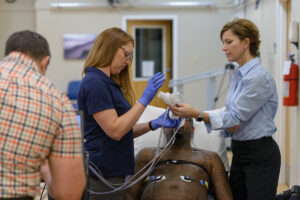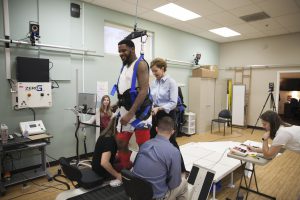New Research Publications

Back to physical health resource hub
Dr. Eugene Rankin, along with Drs. Jazarevec and Rona Altaras, were published in the Journal of the Intensive Care Society, an international critical care journal, for their article titled “Comprehensive brain injury agitation management in the critical care setting: Preliminary results on a multidisciplary neurobehavioral approach.” The article highlights the Trauma Services program at Halifax Health and their novel approach to comprehensively manage agitated TBI patients within the ICU by using the Agitated Behavior Scale, which is now used hospital-wide. The program allows for effective management of agitation to allow a seamless transition of patients within the continuum of care.
“This article provides a tangible example of the Joint Venture partnership between Halifax Health and Brooks Rehabilitation, and also demonstrates how hospital culture can be changed by evidence based practices developed in house,” says Rankin.
Dr. Jason Beneciuk’s article on “Targeted interventions to prevent transitioning from acute to chronic low back pain in high-risk patients: development and delivery of a pragmatic training course of psychologically informed physical therapy for the TARGET trial” was published in BioMed Central’s Trials journal for his innovative research on diagnosing and treating low back pain (LBP). LBP is a public health concern and the leading cause of disability worldwide. Psychologically informed physical therapy (PIPT) is a secondary prevention approach that first aims to identify individuals at high risk for transitioning to chronic pain, and then providing tailored non-pharmacologic treatments to reduce that risk. Dr. Beneciuk, who is currently conducting studies on implementing a PIPT training program at Brooks, developed, tested, and modified an iterative process that consisted of stakeholder engagement from clinicians, brief online educational modules, and a live 8 hour workshop that included video-based mock case scenarios and case-based role playing. Attitudes, beliefs, and confidence in implementing PIPT principles were assessed before and after training to measure training quality and impact.
Dr. Carolyn Geis, co-author of a multi-center trial titled “Optimal muscle selection for OnabotulinumtoxinA injections in post-stroke lower-limb spasticity: A randomized trial,” was published in this month’s (May 2019) edition of the American Journal of Physical Medicine and Rehabilitation. The aim of the study was to identify optimal muscle selection patterns for onabotulinumtoxinA, a treatment for post-stroke lower limb spasticity. Post hoc analyses suggested additional injections into toe flexors improved ankle Modified Ashworth Scale and Clinical Impression of Change scores. Dr. Geis and the rest of the study team have presented at American Academy of Neurology, World Federation of Neurorehab, International Parkinson’s Congress, and the American Academy of Physical Medicine and Rehabilitation.
Dr. Arian Vistamehr, Clinical Research Engineer at the Brooks Motion Analysis Center, was recently published in not one, but two journals. Her article, “The influence of locomotor training on dynamic balance during steady-state walking post-stroke,” published in the Journal of Biomechanics, assessed the influence of a locomotor training program on dynamic balance to determine if improvements in walking speed are associated with improved balance control. Results from the study showed that a higher pre-training walking speed was associated with higher gains in dynamic balance post locomotor training. Dr. Vistamehr was also published in the Journal of Biomechanical Engineering for her review on “Dynamic Balance during Human Movement: Measurement and Control Mechanisms.” The article explains how various clinical and laboratory-based measures can be used to assess balance control and be translated to clinical care with the goal of improving rehabilitation outcomes.






